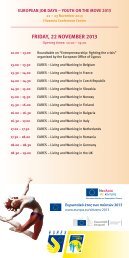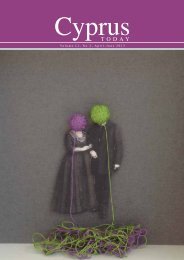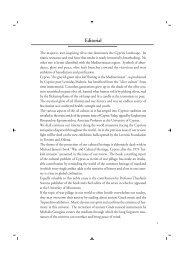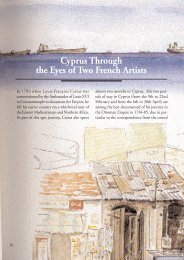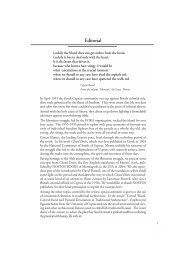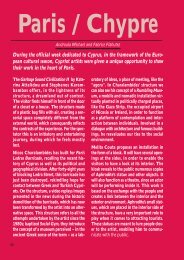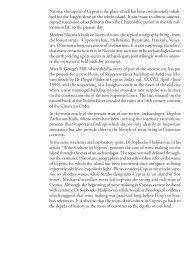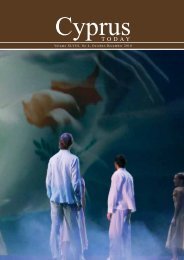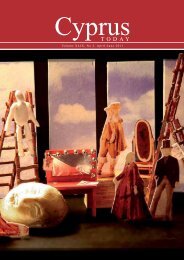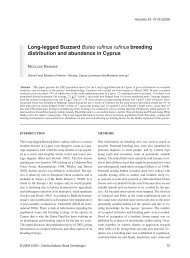Cyprus
Cyprus
Cyprus
Create successful ePaper yourself
Turn your PDF publications into a flip-book with our unique Google optimized e-Paper software.
through the printed word as prophetic. I was<br />
not destined to meet him in person until three<br />
years later. But the question he asked in one<br />
of his poems written in July 1974 and belonging<br />
to his collection “Achaeans’ Shore”<br />
is still unanswered:<br />
What were we doing, I ask, all these years?<br />
[…]<br />
We became old filled with obstinacy and<br />
stupidity,<br />
without responsibility, roots and wings.<br />
And with our pouch of common sense empty.<br />
A year later, when I started preparing a study<br />
of the Cypriot literature chronicling the events<br />
of the invasion, I discovered, much to my joy,<br />
that Charalambides had gathered and chronicled<br />
the first year’s poetic output on the subject.<br />
He even suggested the possibility of an<br />
anthology of the poetry inspired by the Turkish<br />
invasion. He was already setting up camp<br />
on his own patch of the past, trying to mend<br />
a big deformity on the garment of Hellenism.<br />
I had the rare and sad privilege in 1974 to<br />
visit my village and ancestral home in occupied<br />
<strong>Cyprus</strong> a few weeks after the invasion.<br />
I expressed my thoughts generated by that<br />
experience in an unpublished essay, “The<br />
Long Road to Dhiorios.” Wartime conditions<br />
did not allow us to follow the direct route<br />
from Nicosia to the village on the northwestern<br />
part of the island. Escorted by Turkish<br />
officers, we had to go through Kyrenia and<br />
the coastal villages toward Myrtou, villages<br />
whose abundant lemon and orange groves<br />
had already started to wilt and dry because<br />
of lack of water. The process of transforming<br />
the occupied part of the island in “Turkey’s<br />
image” was already in full swing. The questions<br />
raised by the poets and other thoughtful<br />
Cypriots were with me every inch of the<br />
way, as I visited the abandoned and looted<br />
ancestral home, chatted with the few enclaved<br />
villagers who had stayed behind and<br />
who offered me the last fruit I tasted from my<br />
36<br />
village. They smiled sadly at my gesture of<br />
taking the house key with me as I was leaving.<br />
And when I returned to Nicosia that<br />
evening, many of the refugees, displaced<br />
from their homes and scattered throughout<br />
the island who had heard that I had visited<br />
the village, sought me out to ask, in agonized<br />
voices, if a relative was still alive, or if their<br />
houses were still standing. I revisited the village<br />
thirty years later, in 2004, but this time I<br />
was not allowed to enter the ancestral home<br />
which was occupied by a family from Turkey.<br />
I am almost grateful I was not allowed to set<br />
foot in my parents’ home under these circumstances.<br />
Seeing the abandoned old church of<br />
Hagia Marina in ruins and the newer church<br />
of Prophet Elias now turned into a military<br />
hospital, and the village school now occupied<br />
by a family, was enough exposure to the ruins<br />
caused by fratricide and war. I make references<br />
to these incidents of my visit to the village<br />
on these two occasions because similar ones<br />
are echoed in the poetry of Charalambides.<br />
It never fails. Meeting a compatriot anywhere<br />
in the world becomes tantamount to undertaking<br />
a journey back to the homeland. And so<br />
it was with me, when in November of 1977 I<br />
met Kyriakos Charalambides for the first time



